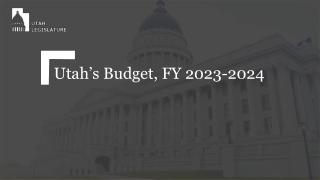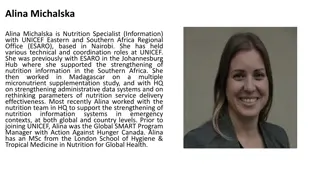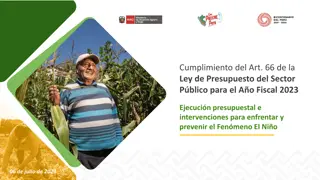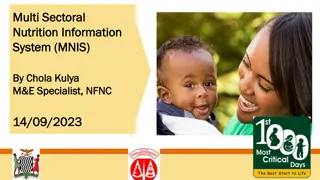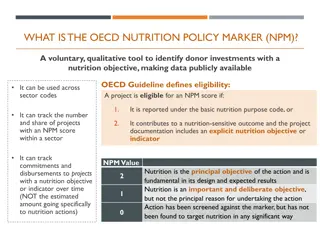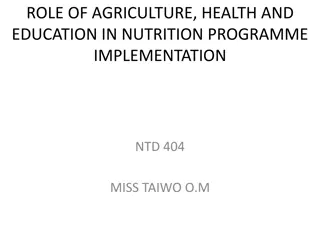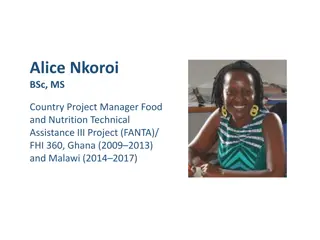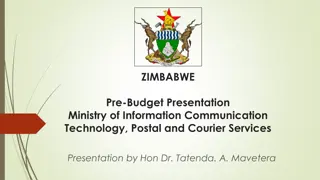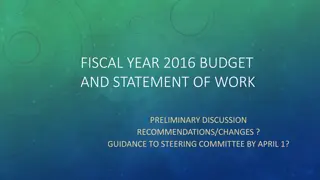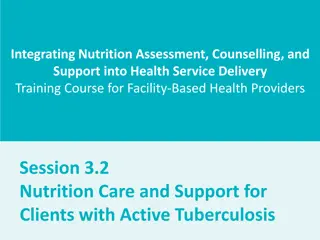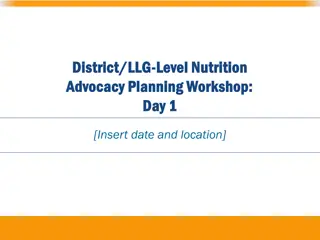Workshop on Tracking of Nutrition-Relevant Budget Allocations: Conclusions and Recommendations
Key findings and recommendations from the workshop held in Bangkok on tracking nutrition-relevant budget allocations. Analyses focused on national government budgets, challenges in identifying nutrition-specific interventions, and the importance of clearer criteria for nutrition-sensitive programs.
Download Presentation

Please find below an Image/Link to download the presentation.
The content on the website is provided AS IS for your information and personal use only. It may not be sold, licensed, or shared on other websites without obtaining consent from the author.If you encounter any issues during the download, it is possible that the publisher has removed the file from their server.
You are allowed to download the files provided on this website for personal or commercial use, subject to the condition that they are used lawfully. All files are the property of their respective owners.
The content on the website is provided AS IS for your information and personal use only. It may not be sold, licensed, or shared on other websites without obtaining consent from the author.
E N D
Presentation Transcript
Workshop on tracking of nutrition- relevant budget allocations Bangkok, April 15-16 2015 Conclusions and recommendations
Conclusions Key findings and experiences from the country exercises Analyses focused on national Government budgets publically available a wide range of different sectors/Ministries/programmes were included Did not include local government/decentralized budgets, off-budget donor, NGO, multilateral and private funding In national budgets, difficult to identify the nutrition specific interventions as per the Lancet so some focused on proxy programmes targeting the 1000 days Weighting exercise of nutrition-sensitive interventions was challenging and highly varied; no standardized approach between countries Cannot link investments directly to impact/outcomes The results of this exercise should not be considered final: first step
Conclusions On nutrition-specific: Consensus to use the Lancet recommendations for nutrition-specific interventions But sometimes school feeding or food aid , for example, may be categorized as nutrition-specific , when they are not targeted to nutritionally vulnerable groups, do not have specific nutrition objectives (1000 days) - and no evidence of impact stunting/undernutrition Misleading outcomes a critical risk of this exercise.
Conclusions On nutrition-sensitive The Lancet is a useful starting point together with the UNICEF conceptual framework on underlying determinants and the list on nutrition outcomes from the Donor Network. But questions remain on: which programmes/interventions to include in non- Health and Nutrition sectors, with clearer criteria on nutrition sensitivity and presence of deliberate nutrition objectives and indicators, focused on 1000 days
Conclusions On weighting: Weights assigned for similar interventions varied widely between countries Need for clearer, standard definitions, criteria, norms Although not aiming to compare countries Need to obtain sufficient information about programs in order to determine which components are nutrition-sensitive, otherwise better not to assign any weighting (e.g. water supply ) Cap at 75% for nutrition-sensitive 25% is too high in some cases Discussed and agreed on a series of questions (personnel, disease prevention and control, nutrition in emergencies, dietary diversification, in-kind food distribution in social protection, school feeding)
Conclusions A key objective is to estimate the baseline budget allocations for nutrition-specific & identify gaps. = MORE MONEY FOR NUTRITION Urgent need to focus resources on scaling up nutrition specific interventions Key advocacy tool will be the analysis of the gap between available budgets and well- costed plans
Conclusions The analysis of other sectors on nutrition sensitive interventions needs to start with identifying how nutrition-sensitive programmes are, and whether they are addressing undernutrition (or not) Starting point should not be to present a picture with large investments, which may be unfocused Aim is to shape the programmes and interventions to be more nutrition sensitive, to be able to address undernutrition = MORE NUTRITION FOR THE MONEY
Conclusions Large risk if estimates for nutrition-sensitive budgets including many programmes and costs which are unrelated to nutrition outcomes - are presented as the total available envelope for nutrition Could result in decision-makers and donors perceiving that sufficient financing already exists for nutrition And result in nutrition-specific interventions continuing to be underfunded
Recommendations Before embarking on these exercises, need to be very clear on the aims: more investment in scale up of nutrition specific interventions and making key sectors more nutrition sensitive Standardize definitions and create a more detailed checklist, criteria and menu of examples, of nutrition- specific and nutrition-sensitive interventions, while allowing for contextualization. Conduct a peer-review process and/or independent expert review of country budget analyses towards greater harmonization of criteria/definitions Use more flexible ranges of weighting, including <25%, and only of programmes which are clearly nutrition-sensitive
Next steps Global Nutrition Report will feature these initial efforts to estimate nutrition-relevant budgets, reflecting nutrition-specific and sensitive where possible Countries who wish to update/finalize their estimates for inclusion encouraged to do so within the next two weeks
Second Asia workshop Second Asia workshop to be held in Oct/Nov 2015, targeting: rest of Asian SUN countries Countries/States considering joining SUN Selected countries from this first workshop, to share analysis, experiences, lessons Focus will be on financial tracking, but also costing, financial gap analysis, costs of undernutrition, cost-effectiveness, investment cases

